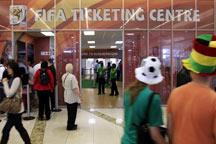 Apr. 15, 2025
Apr. 15, 2025
Weather
Beijing to expand the scope of staggered working hours arrangement
2009-06-03 14:20 BJTWhen a rule was launched after the Olympic Games which determines if a vehicle can be driven during a specific day of the week based on the last digit of its license plate (license plate last digit restriction rule), the arrangement's scope of influence shrank to large-scale department stores. This move meant that all other enterprises and public institutions and organizations other than large-scale department stores were no longer subject to any compulsory restrictions with respect to working hours.
The plan issued on June 1 clearly stipulated that Beijing will expand the scope of the arrangement's implementation, and that working hours will be studied and adjusted for party and government departments at all levels in Beijing.
In addition, the plan further clarified that enterprises, public institutions and social organizations will be encouraged this year to adopt flexible working hours if conditions permit, and the government will also promote the practice of working online.
A new pedestrian and bicycle transportation system will be planned within the year
The plan stressed that the license plate last digit restriction rule will continue to be enforced this year, and Beijing will continue to find long-term measures to deal with congestion. In addition, a new system of diversified paid parking rates will be studied and implemented; vehicles will be encouraged to park at designated parking lots through economic incentives. The aim is to reduce the number of vehicles entering the central urban area and alleviate the traffic congestion in downtown Beijing.
In response to the type of traffic congestion incurred as a result of a rush for passage among pedestrians, cyclists and motor vehicles, the plan also revealed that a new transportation system for cyclists and pedestrians will be planned within this year. Also, a guideline on traffic planning for pedestrians and cyclists in Beijing will be created, while a project will be implemented at the same time to optimize and upgrade the existing infrastructure for pedestrians and cyclists in key areas such as CBD and Guang’anmennei Street as well as areas with large passenger flows.
Congestion alleviation measures in 2009:
Construction of 100 new high-speed electronic toll collection roadways: The scale of toll collection systems (ETC systems) will be expanded by constructing 100 new ETC system-based roadways on highways like Badaling Expressway and Beijing-Shijiazhuang Highway.
Transformation of the Second and Third Ring Roads to alleviate congestion: Regional congestion is likely to occur during rush hours in the morning and evening, as there are regular congestion points in the urban area of Beijing as well as densely-built bus stops at entry and exit points along the Second and Third Ring Roads. During 2009, Beijing will construct 20 bus bays on main and side roads where the necessary conditions are met for the construction of a bus bay, like Liuliqiao, Zhaogongkou, Shuangjing, Baijiazhuang and Xiju.
Construction of four new expressways: Four urban expressways will be constructed on Puhuangyu Road, Guangqu Road, Fushi Road, and the road to be created by the first-phase project for the western extension of Xiwai Avenue.
Alleviating congestion at Tiantongyuan: to complete the construction of the project for the northern extension of Beiyuan Road and Beiyuan East Road within this year
Alleviating congestion at Dongzhimenwai: to begin construction on Dongzhimenwai Diagonal Street, Xiangheyuan Road and Gongti Diagonal Street
Residents: The implementation of the arrangement to avoid peak traffic hours by establishing staggered working hours made no difference to the traffic flow after the Olympic Games.
It was heard on June 1 that some businesses and organizations are still implementing staggered working hours after the Olympic Games last year, some residents claimed that "staggering working hours made no difference to the traffic flow.”
"The speed is not slow, but the train is too crowded, especially at transfer stations. It is almost impossible to get on the first train arriving at the platform after I get there," said Ms. Zhou, a resident of the Guangzhuan area in Beijing who works in Chaoyangmenwai and who commutes to and from work by taking Subway Batong Line, Line 1 and Line 2 every day. She also pointed out that in last July and August, the benefits from staggered working hours could actually be felt when implemented on a large scale, adding, "we thought that the subway passenger flow would increase substantially when the license plate last digit restriction rule was first implemented. But it turned out that there was no big increase in passenger flow. After the Olympic Games however, the train seems to become more and more crowded, causing people to think that the arrangement had already been canceled."
Translated by LOTO
Editor: Shi Taoyang | Source: CCTV.com Mail
Mail Share
Share Print
Print


 Video
Video









 2009 China Central Television. All Rights Reserved
2009 China Central Television. All Rights Reserved